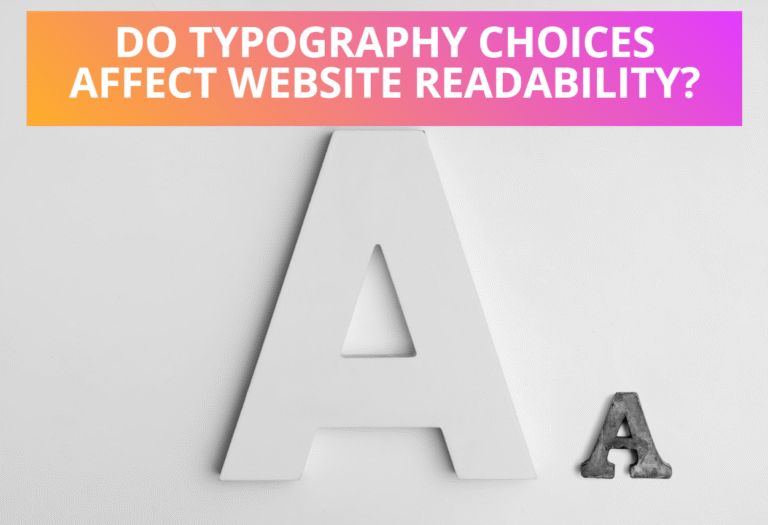Website design benefits greatly from typography, which remains an unrecognized yet essential element. The goal isn’t merely to make text visually appealing but to craft an engaging user experience that encourages visitors to return. Bad typography choices can send visitors packing more quickly than the words “Comic Sans” can be spoken.
Proper typography design turns your website from an overwhelming block of text into an inviting and user-friendly experience. When done correctly, typography helps
- Guide visitors through your content
- Establish your brand identity
- Keep visitors on your site longer
This guide explains how typography choices affect your website’s readability and usability while offering actionable advice to prevent common website design errors.
What you’ll discover:
Table of Contents
1. Why Typography Matters for User Experience
Functional elements define typography beyond its aesthetic appearance.
Think about it.
Most visitors decide within 15 seconds whether to stay on your website. The typography choices you make will determine whether you succeed or fail in creating a memorable first impression.
2025 Australian web design trends show that high-contrast typography pairings combined with unique letterforms lead to enhanced visual communication and brand identity, which improve usability and readability. The content becomes more readable when bold fonts are combined with subtle backgrounds because this pairing reduces eye strain.
Poor typography choices lead to:
- Higher bounce rates
- Lower time on page
- Frustrated users
- Lost conversions
Effective typography designs an intuitive reading journey that leads users through your content. It creates a visual hierarchy and enhances content understanding, which enhances your website’s ability to reach its objectives.
Did you know that many top website designs now use typography as the foundation of their entire visual identity? The role of typography has shifted from basic functionality to becoming essential for defining brand identity and improving user interaction.
Read Also: The Ultimate Guide to Stylish Text in Digital Marketing
2. Key Typography Elements Affecting Readability
This part examines which typography elements determine how visitors can easily understand your content.
Font Size
Too small, and visitors strain their eyes. Too large, and they can’t scan efficiently.
Australian brands frequently select large, bold fonts to create a strong visual statement and ensure better readability through enhanced visual hierarchy. The design helps improve usability through enhanced content scanning and comprehension for users.
Line Length
Body text should maintain a line length of 50 to 75 characters. Extended line lengths hinder the reader’s ability to move from one line’s end to the next line’s start.
Line Spacing (Leading)
Appropriate spacing between lines creates a comfortable reading experience by preventing cramped text and enhancing reading flow. Websites now optimize typography across devices thanks to variable fonts, which automatically adjust for different screen sizes and resolutions, resulting in better readability.
Font Weight
The visual distinction between the heading and body text establishes a visual hierarchy that directs readers through your content.
Font Choice
The choice between serif and sans-serif fonts affects reading speed beyond their stylistic differences. 2025 web design trends feature expressive and variable typography as a central element, while bold fonts serve to capture attention and define brand character as well as direct user interactions on websites.
Contrast
The text should maintain a strong contrast with its background to ensure readability. Web designs in 2025 utilize calming color schemes and expressive typography to minimize eye strain while maintaining user attention on web pages. This comprehensive strategy enhances usability through a balance of visual beauty and readability.
3. Typography Mistakes That Drive Visitors Away
Discover which elements cause visitors to leave your website immediately. The following typography mistakes are critical to avoid on your website:
Too Many Fonts
Web design becomes visually chaotic when more than 2 to 3 font families are used. A uniform typographic style across your website strengthens your brand identity.
Poor Contrast
Although gray text on a light background appears stylish and minimalistic, it creates significant readability issues. Maintain appropriate contrast levels between your text and background to enhance readability.
Ignoring Mobile Users
The typography that performs well on desktop displays fails to function properly when viewed on mobile screens. Since mobile devices drive more than 60% of website visits, responsive typography becomes essential rather than optional.
Inconsistent Styling
The trustworthiness of your site diminishes when users encounter different heading styles and paragraph formats on each page.
Tiny Text
While small text allows more content above the fold, users find it frustrating. Users will not engage with text that proves difficult to read.
4. How to Choose the Right Fonts for Your Website
The process of choosing typography relies on its effectiveness for the specific audience and content, beyond its visual appeal. Here’s how to make smart typography choices:
Consider Your Brand Personality
Are you formal or casual? Traditional or innovative? The fonts you select for your website need to match your brand values and voice.
Prioritize Readability
Choose fonts designed for screen reading. The digital device readability of Georgia, Roboto, and Open Sans fonts was the designers’ main purpose during their creation.
Test on Multiple Devices
Your desktop typography choices might produce poor results when viewed on mobile devices. Ensure your typography looks good on all devices and screen sizes before finalizing your design.
Limit Your Selection
Limit your typography to two or three font families, with one for headings and another for body text. This approach maintains uniformity throughout the text while supporting different levels of emphasis.
Match Font to Purpose
The typography strategy should be customized to match the specific requirements of different content types. Blog posts require specific typography features that differ from those needed for landing pages and product descriptions.
5. Typography Best Practices
While typography trends change over time, fundamental principles of readability remain constant. These guidelines represent the latest best practices in website typography as of now.
Embrace Variable Fonts
With variable fonts, one file can produce multiple font variations through changes in weight, width, and style. Page load speed increases while designers gain greater creative freedom with this feature.
Consider Font Loading Speed
Improper implementation of custom fonts can result in decreased website performance. Implement font subsetting or system fonts along with variable fonts to enhance your website performance.
Use Typographic Hierarchy
Different content levels should stand out visually by varying size, weight, color choices, and spacing between elements.
Make It Scannable
The majority of users browse through content instead of reading each word. Structure your content with headings and subheadings alongside bullet points and highlighted sections to enhance scalability.
Optimize for Accessibility
Ensure the accessibility of your typography by adhering to WCAG standards for text size, spacing, and contrast to support users with visual impairments.
Australian businesses are showing a rising investment in the SEO and content marketing sectors, which is expected to reach $1.5 billion by 2025, marking a 12% growth from 2024. This demonstrates that content accessibility and readability are essential for attracting online audiences.
Wrapping It All Up
Typography serves as the core element that determines how users interact with and perceive your website content. When you make typography choices with readability and usability in mind, you enhance both the appearance and the functionality of your site.
The right typography choices can:
- Keep visitors on your site longer
- Guide them through your content effectively
- Establish brand identity and recognition
- Improve the overall user experience
The essence of typography requires maintaining an equilibrium between aesthetics and functionality as well as brand personality and universal readability and balancing current trends with timeless principles.
Implementing best practices and avoiding common typographical mistakes will enable you to develop a website that offers both visual appeal and true user-friendliness.
Which typography modifications will you apply to your website in today’s session? Please share your thoughts in the comment section below.
Read Next: Responsive Web Design—How to Make A Website Look Good On Phones And Tablets









